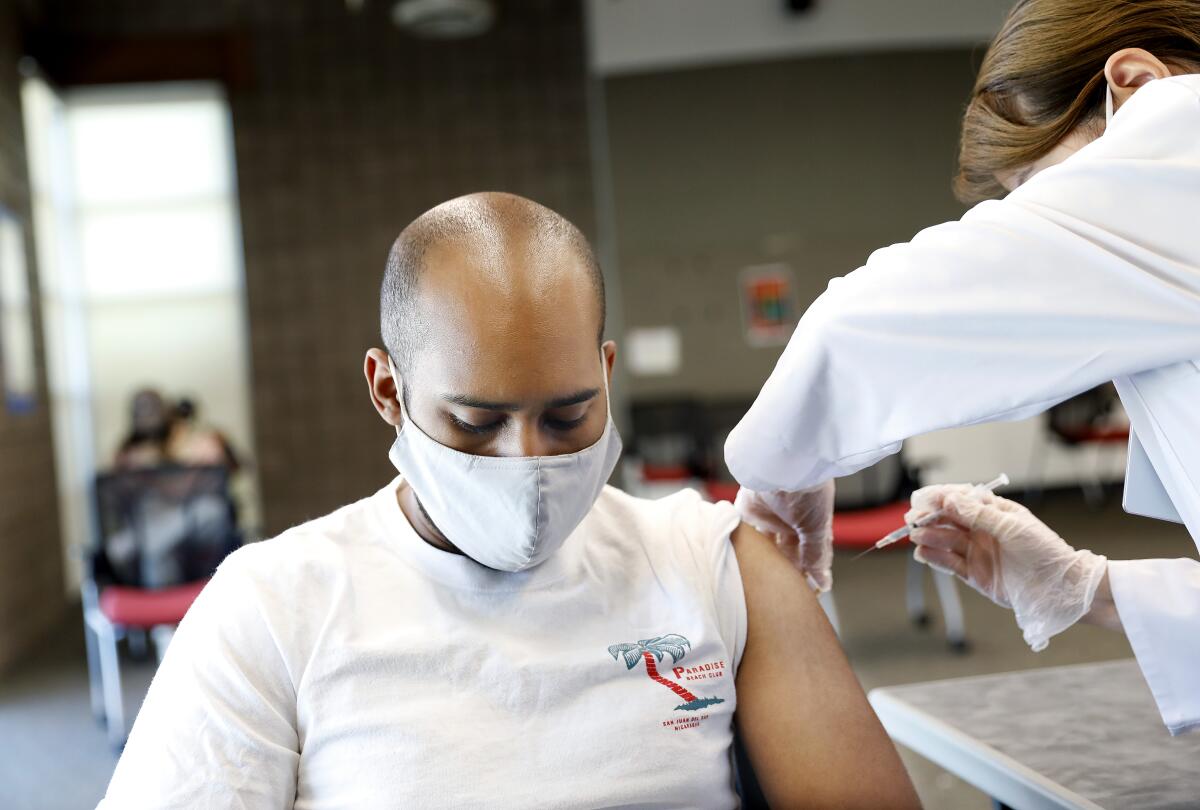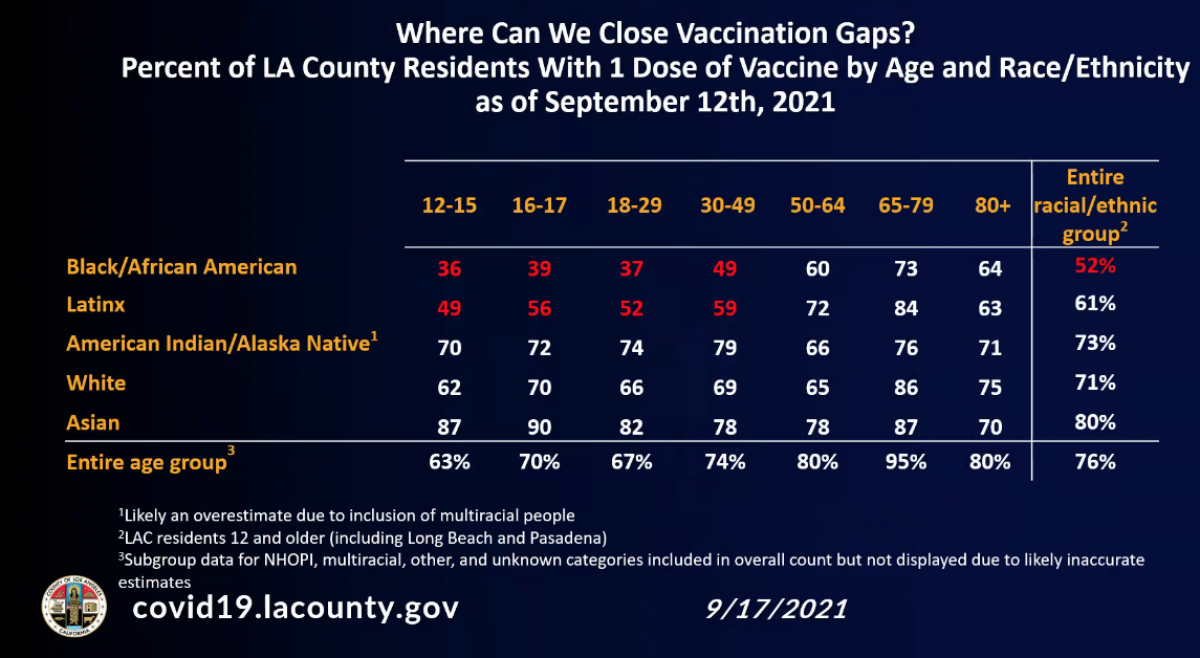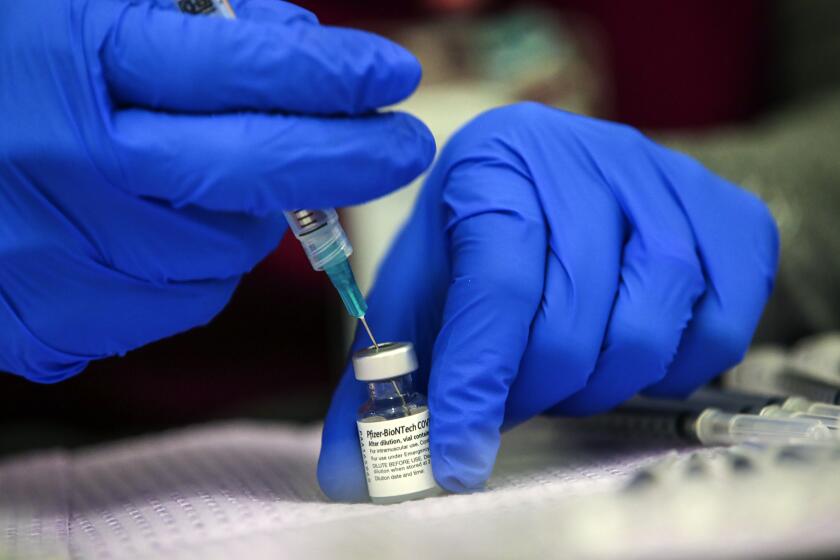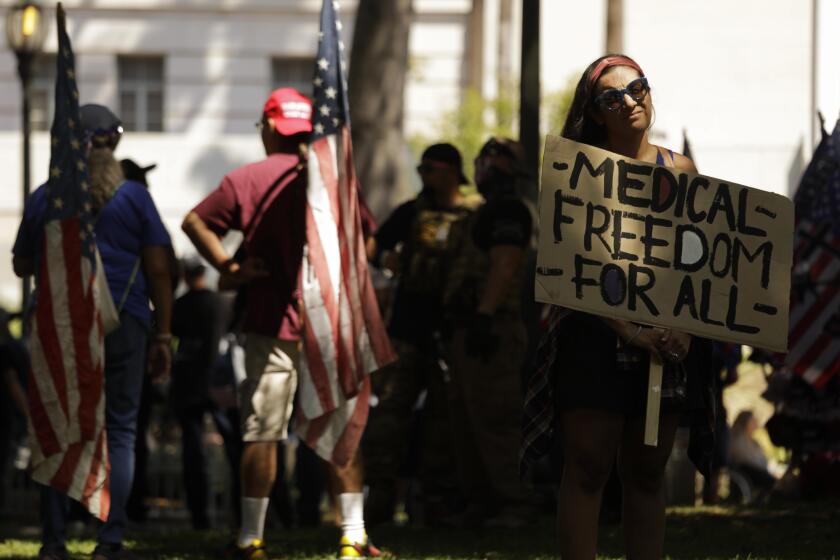COVID-19 vaccination rates lag in younger Black and Latino residents in L.A. County

- Share via
COVID-19 vaccinations are lagging the most in younger Black and Latino residents of Los Angeles County.
Vaccination rates among L.A. County’s Black residents up to age 49 remain below 50%, and rates among Latino residents in the same age group remain below 60%, health officials said this week.
These rates are far below that of older Black and Latino residents, as well as white, Asian American and Native American residents of all age groups in L.A. County.

“These persistent gaps need to worry all of us, as the unvaccinated people in each of these subgroups are still able to catch and transmit the virus very easily,” L.A. County Public Health Director Barbara Ferrer said. “And of even greater concern, they’re at risk for becoming severely ill or dying as a consequence of infection.
“Our collective health is also threatened by these gaps, which give plenty of opportunity for high transmission and the emergence of additional variants that may be resistant to our vaccines. Additional surges are likely in the absence of better vaccination coverage,” Ferrer added.
Moderna’s COVID-19 vaccine does a significantly better job of preventing COVID-19 hospitalizations compared with Pfizer’s shot.
It’s essential that more people get vaccinated for any hope of ending the pandemic, Ferrer said.
“In many cases, the difficulty increasing vaccination uptake in low-coverage communities is linked with distrust in the medical system and in government — borne out by long histories of poor treatment,” Ferrer said. “Repairing the damage caused by healthcare inequities will not happen overnight, [but] we must not worsen these inequities by inaction in closing coverage gaps, which will further worsen existing disproportionality we see in cases, hospitalizations and deaths.”
Unvaccinated Black and Latino residents are significantly more likely to contract the coronavirus compared with their white and Asian American counterparts, according to county data from August. Unvaccinated Black residents are also more likely to be hospitalized than other racial and ethnic groups.
Unfortunately, the pace of vaccinations is not nearly enough to dramatically help get L.A. County close to herd immunity, in which sustained transmission of the coronavirus is dramatically interrupted, anytime soon.
“It is clear that our vaccination progress is stalling, and we need to move in a different direction to avoid future surges in cases,” Ferrer said, which is a big reason why she has supported targeted vaccination requirements for workers and for customers in certain high-risk public settings, such as bars and crowded settings.
In Orange County, Deputy Health Officer Dr. Regina Chinsio-Kwong said there’s more work to be done getting vulnerable communities vaccinated. Even though cases and hospitalizations have begun to decline, she said, “now is not the time to relax. We really want everybody to get vaccinated if they haven’t already.”
Unfortunately, the areas in Orange County with the lowest vaccination rates “have not really changed as much over the last couple of weeks,” Chinsio-Kwong said.
Lagging vaccinations are apparent among Latino residents as well as younger adults in their 30s. “This age group has been less vaccinated than other age groups,” Chinsio-Kwong said.
Areas where vaccination rates especially need improvement include Santa Ana and the UC Irvine campus, according to data released by Chinsio-Kwong, as well as coastal communities of Huntington Beach, San Juan Capistrano, San Clemente and Newport Beach.
Already in Orange County, the average age for those hospitalized with COVID-19 is now younger than in previous surges, Chinsio-Kwong said, which experts say is probably due to younger people having a lower vaccination rate than older people. The average age of an unvaccinated person hospitalized for COVID-19 was 66.5, far younger than the average age of a vaccinated person hospitalized for the disease, 84.
About 100 people show to mostly peaceful anti-vaccine rally at Los Angeles City Hall.
There’s still a lot of misinformation circulating about the vaccines in Orange County, said Isabel Becerra, chief executive of the Coalition of Orange County Community Health Centers, in a recent briefing for reporters.
One of the biggest myths, Becerra said, is that the vaccines will affect fertility or that the vaccines will alter a person’s DNA. Those ideas are false. The U.S. Centers for Disease Control and Prevention has urged pregnant women to get vaccinated, and officials have warned of the severe illness and complications that can happen if those who are pregnant fall ill with COVID-19.
Mary Anne Foo, executive director of the Orange County Asian and Pacific Islander Community Alliance, said her group has also been trying to educate people about the vaccine and swat down misinformation.
Some have worried about how the shots haven’t existed for a long time; Foo and her group point out that the studies and research behind the COVID-19 vaccines have been developed over a significant period of time.
Nationally, according to a Kaiser Family Foundation survey on vaccinations, 70% of white adults have already received at least one dose of vaccine, while 65% of Black adults have and 61% of Latino adults have. Groups that are less likely to have received a shot include white evangelical Christians, younger adults ages 18-to 49, rural residents, Republicans and uninsured people younger than 65.
More to Read
Sign up for Essential California
The most important California stories and recommendations in your inbox every morning.
You may occasionally receive promotional content from the Los Angeles Times.















